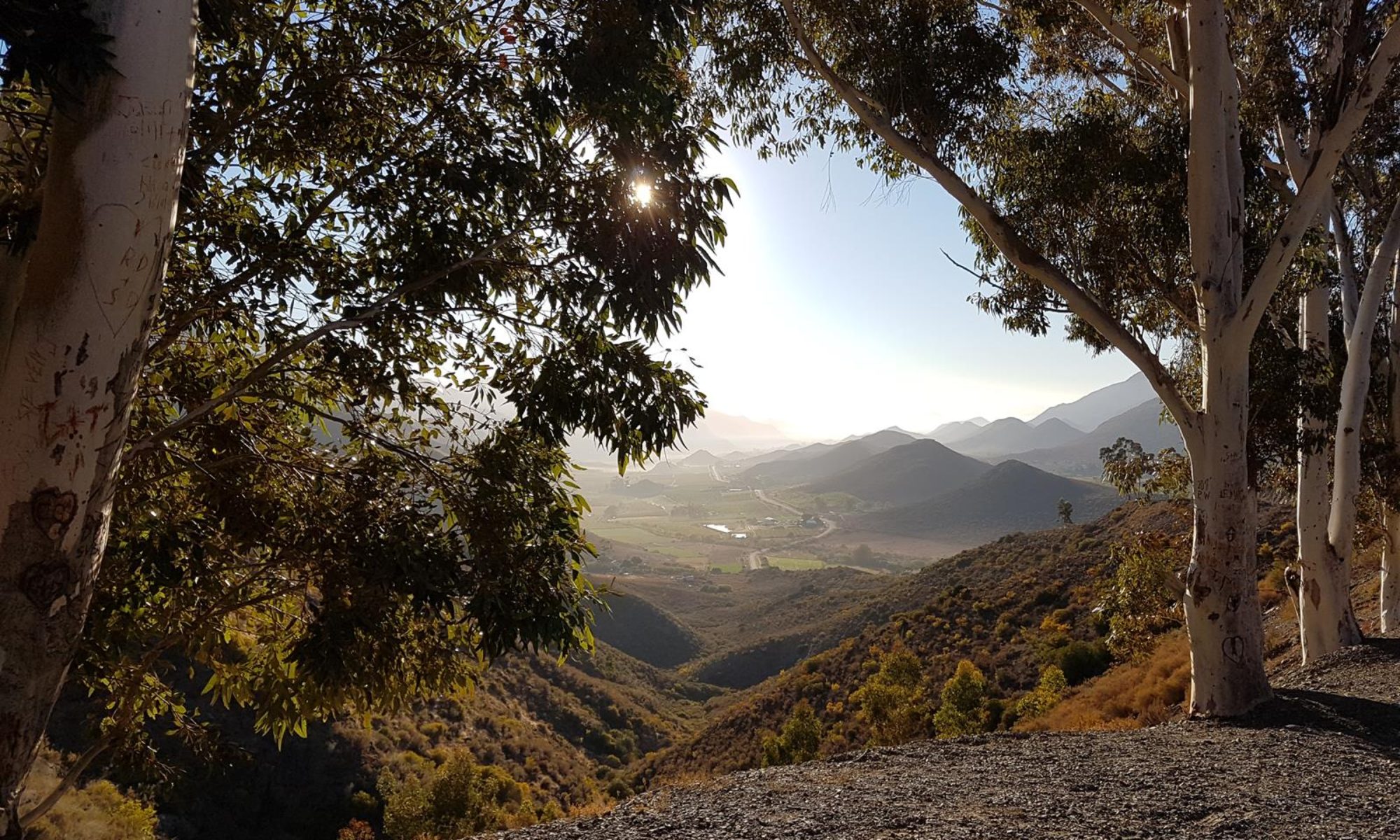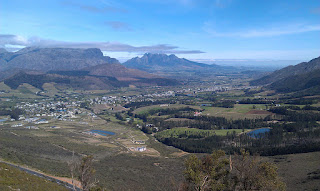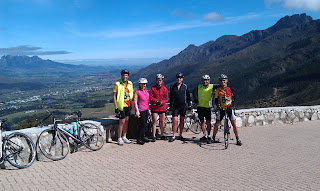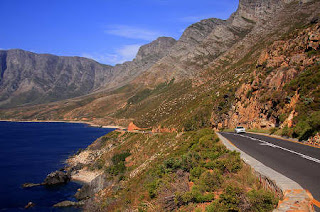Looking at the hill profile above for the Double Century (DC), you’d be forgiven for thinking that all the hard work is getting over those two hills in the first 63km and that it’s all downhill after that. If you look more closely at the last 40km, you’ll also spot what old hands at the DC refer to as either ‘Dolly Parton’ (two big bumps) or the “Three Bitches” (depending on how you count them). On this year’s DC however, it was the weather that delivered the most painful blows, eclipsing by far anything the route itself could throw at us.
The morning was still dark as our team gathered in front of the Caltex garage in Swellendam, hastily pinning race numbers on each others backs, dropping coolbags full of supplies in the trailer now hitched to Peter’s car, and making last minute checks of our bikes. Despite two late withdrawals, somehow we were a full complement of 12 riders free-wheeling down Station Street to our start chute. A rag tag bunch maybe, with a few of us meeting for the first time on the morning, but at least we were all there and ready to go – something not every team had managed, as riders rushed around us late to join their teams, some even missing their start time completely..
As our team shuffled towards the start mats, I felt a little overwhelmed – unsure how I’d got nominated as team captain when we had a number of riders with past DC experience, at least five of whom had done the ride many times in the past. Suddenly the few words of team talk I had in mind seemed rather pointless when we had guys who knew far more than me about the course ahead, the perils of starting out too hard, and the need to eat well early in the ride. I think I mumbled something about us having done the hard part by getting to the start line trained and ready, and all we needed to do now was pedal to the end. As it turned out later, I needn’t have worried – those experienced guys would be a great asset to us on the ride, far more so than any words I could have come up with.

We crossed the start line with Ralph up front, I don’t recall who was alongside him. Before we fully left the town, Jack and I took up the reigns upfront. The riding was easy with the freshening wind on our backs, and we flew along that first stretch of the N2 highway to the left turn for Suurbrak, and the start of a very welcome and long stretch of closed road to make the cycling much more relaxing. I settled into myself over those opening kilometres, my worries about being captain fading away as we worked our way into the ride.
Tradouw Pass certainly lived up to expectations in terms of scenery, a truly stunning stretch of road winding through rocky gorges, across mountain streams, and climbing up fynbos clad mountainside. The sky was dark again now though, this time with heavy grey clouds, the wind picking up considerably as we crested the pass, and threaded our way through the water stop. A few of our riders immediately regretted picking up water bottles when confronted with an acrid taste of plastic flavoured water on their first sip – clearly the organisers had not bothered to wash out the new bottles, something I had spent the previous evening doing for all 12 of our event supplied bottles. Ralph shouted a warning across to all of us about the speed of the upcoming descent, and with that in mind we whizzed down the other side.
Having studied the route profile many times, I’d somehow got the impression that the Op de Tradouw climb came almost immediately after Tradouw Pass, but with my Garmin only showing 35km it was clear that we had a quite a few kilometres before the second big climb of the day. They passed fairly quickly, and although crossing some fairly picturesque and rolling farmland, there are only a few fragments of this part of the ride which stick in my memory. One of these was Danie’s regular warnings that The Beast was just ahead, and to keep our pace steady. Another was a bizarrely apt farm sign for ‘Quads‘ – at this point many of us would gladly have stopped in for some replacement quadriceps ahead of the big hill, if only that had been what they were offering.
I started to feel a little complacent as we ground our way up Op de Tradouw. Jack had told us to ignore the false tops until we saw a row of pines come into view. The road twisted it’s way up and we followed it slowly, Ralph regaling us with an endless stream of jokes and one liners which did a superb job of taking our minds off the work. And before we knew it, Jack’s landmark trees came in to view and the “big climbs” of the day were all done. Both ahead and behind us though, the day’s real troubles were only just getting started.
Behind us, our last minute substitute Darren was struggling and had dropped off our group, Clayton having spotted this dropped back to help him up the hill. We learnt later that Darren was not fully over a bout of flu, and had still being having jabs until a day or two before.
Ahead of us an even more ominous threat was building – no longer sheltered by the hill we had been climbing, the full force of the North West wind blasted us, now whipped up into a full on gale. Prior to the race I’d imagined the 63km feed station would be a welcome relief after the big hills, and a place to gather breath and look forward to easier kilometres ahead in the middle of the ride. The reality though was very different – sure, we did have some nice cold energy drinks (in clean bottles) and snack bars to restock with, but with rain now starting to fall, the kilometres ahead felt anything but easy. Sure enough, within minutes of starting off again, Marc was blown right across the road and almost into the ditch – the crosswind picking up his deep dish wheels and chucking him around like a rag doll. That fast descent was a scary section for many of us, but Marc was literally battling to stay on his bike and in the ride.
By now, the rain was heavy, very heavy. The decision earlier that morning to leave my jacket at home now didn’t seem such a good one – I wasn’t especially cold, but I was soaked through. We were also now short of firepower to battle the ferocious cross and headwinds too. Clayton had suggested I took the lead group on ahead to the support stop in Ashton, and he’d help Darren along who was still struggling. Danie, and Ralph had also dropped back to help out too, so the workload up front fell largely to the remaining big guys in alternating turns: myself, Styger, Jack, Chris, and Marc when the wind allowed.
Sadly, none of us would see Darren again until after the ride. As we took the left turn just before Montagu and headed towards Cogmaskloof, Danie, Ralph and Clayton rejoined us with the news that Darren had realised he was not going to be able to finish and pulled out. It was a blow to lose a team-mate already, just halfway into the ride. The DC had become a minor obsession for me over the last few months of training, and I knew Darren would be no less disappointed not to have completed the ride. It only occurred to me later that being down to 11 riders, also meant we wouldn’t qualify for a Charles Milner medal for completing the ride as a full team.
Cogmaskloof is a flat gorge that starts by dipping down through a short tunnel dynamited through an archway of rock, and then meanders between neighbouring mountainsides before opening and dropping you out onto the farmlands around Ashton. Through this stretch the wind was directly into our faces, making for very slow progress. To combat this, our experienced riders showed the rest of us how to set up a rolling echelon – a continuous loop of riders where the outside of the loop has riders heading up to take the front briefly until the rider behind them passes and takes over. The inside column is lead riders who are passed slowly dropping back relative to the outside column. As the tail of the outside column passes the last rider, a call of “last rider” goes out, and the last rider of the inside column goes across the bottom of the loop and starts to make way up the outside again. Aside from being a mesmeric and remarkably pleasing formation to watch, the echelon also helped us maintain a much faster pace against the strong headwind than we would have been able to do in normal dual or single line formation.
 Once through the kloof, there was a short pacey blast through the outskirts of Ashton, and down the main street, followed by a left turn across the railway tracks and the timing mats into the neutral support zone. It immediately became clear what others had told me about us having a top support crew Peter and Adele when we saw our team car – coolboxes all laid out, bikes and water bottles taken from us as soon as we pulled up. Those few minutes off the race clock were very welcome to grab a breather and a bite. In my case, I took a fresh energy drink bottle for my bike, stuffed another packet of new potatoes into my pocket to replace the one eaten earlier, downed a chocolate Sterrie Stumpie and hastily scoffed a peanut butter sandwich.Without such good team support, we could have messed around in disorganized chaos, but with an efficiently managed stop done we were under-way quickly, my belly already complaining about being too rapidly stuffed with too much food and drink.
Once through the kloof, there was a short pacey blast through the outskirts of Ashton, and down the main street, followed by a left turn across the railway tracks and the timing mats into the neutral support zone. It immediately became clear what others had told me about us having a top support crew Peter and Adele when we saw our team car – coolboxes all laid out, bikes and water bottles taken from us as soon as we pulled up. Those few minutes off the race clock were very welcome to grab a breather and a bite. In my case, I took a fresh energy drink bottle for my bike, stuffed another packet of new potatoes into my pocket to replace the one eaten earlier, downed a chocolate Sterrie Stumpie and hastily scoffed a peanut butter sandwich.Without such good team support, we could have messed around in disorganized chaos, but with an efficiently managed stop done we were under-way quickly, my belly already complaining about being too rapidly stuffed with too much food and drink.

As we left the stop, it was suggested we take another quick stop after the circle in Robertson. I was a little doubtful of this initially, being only 20km ahead it seemed way too early to be considering another stop. Swinging out of the neutral zone though, it became clear what a good call it was. Any thoughts that we might have seen the worst of the wind vanished as we were instantly shredded by vicious gusts directly into our faces. We briefly tried to setup the echelon again, but it was obvious it wouldn’t work – Elizna and Desiree being lighter riders got blown backwards as soon as they joined the outside column, and simply couldn’t pedal through the gale to reach the front. We fell back to two lines of riders, with the bigger and heavier riders, myself included, up front to shield the light riders so they could keep up. It took well over an hour until Robertson came into view, the gruelling battle to get there revealing the wisdom of calling for that next stop so soon.
Swinging left at the circle was like having the brakes taken off the bike, the strong wind suddenly now at our backs, pushing us effortlessly along to the waiting team car. The shortest of stops, just a quick swig of coke and Black Cat bar and we mounted up again. Cycling now in sunshine and with the wind behind us, we flew along, my Garmin ranging between 35 and 40km/h for long sections of this stretch.We rode through a purple, Jacaranda lined lane, passing the vineyards of Van Loveren and De Wetshof, where Yoli and I had gone winetasting a few years back with her family.
The kilometres were clocking up nicely now, even with a quick coke stop at the water tables by the right turn towards Bonnievale. My Garmin was soon reading 160km, which was significant not just because it was the longest distance a number of us had ridden before, but also because it meant the start of the much feared “last 40km” of the DC, and our date with continuous rolling hills, and ultimately Dolly herself. No sooner had we started the first of these rollers than Theunis fell off the back of our group. I let the others press on ahead and dropped back to chat with him. One look across, and I could see he was in severe pain even before I heard him say “my knees are killing me, you go on ahead, I’ll hold you guys back“. The team car pulled alongside and Adele said “we’ll help him, you go up to the others“.
I stood on the pedals, and quickly caught up with the back of our group – I wasn’t happy though, we’d lost Darren and now Theunis was battling and looked close to giving up. I knew the ride meant as much to Theunis as it did to me, and I also remembered from the One Tonner that he had a lot of grit too, and quite possibly would be able to battle through if we helped him. As a team though, we had to all be happy to do that and accept a slower finish time as a result. I sprinted to the front of our group and let Ralph and Clayton know Theunis was struggling, and then dropped back to chat with Desiree, who as Theunis’ partner both needed to know, and also could give me her view on whether she thought Theunis would be able to finish if we helped him. Desiree’s words to me were along the lines of “if we leave him to soldier on alone, I think he’ll probably quit, but if we help him I’m certain he can finish“. That was all I needed to hear, so I called a stop and we waited for the team car and Theunis.
As we stood briefly by the car, I did offer that if a fast six wanted to push on ahead for a time, no one would complain, but not one of our rag tag bunch was interested – despite some of us hardly knowing each other, everyone rallied around to help Theunis and give him encouragement and support to finish. And that help was needed as those remaining 40kms unfolded, revealing a painful and continuous sequence of sharp ascents, and short fast descents. Desiree’s prediction proved solid though – Theunis kept going, and going, if anything getting stronger as we pressed on.
A few of us dropped back to give moral support on those climbs, until finally we started at the bottom of the first of Dolly’s bumps, with rain falling heavily again now. In the bottom of the following descent was the much fabled “portage section” – supposedly we were supposed to carry our bikes along a section of dirt road to get around a massive crater where the R60 had washed away in recent floods. In practice, we skidded and slid through most of it, briefly using our road bikes to tackle something more suitable for mountain bikes. Exiting the dirt section onto a slippery descent on wet tarmac I called across to Desiree and Theunis to be careful of skidding as we sped down into the dip, and the start of the last of Dolly’s bumps. The rain was now sheeting down, at some point it turned to hail, although to be honest I forget exactly where – I was so wet by now it was hard to remember. We stopped briefly to try in vain and unlock Theunis’ front brake which was binding, but having failed and with the top so close, we rode on.
The top of the last bump came into view, and there waiting in a narrow shaft of sunlight between the rain clouds, the whole team stood patiently waiting. Knowing there was almost no more work to be done, I heard Theunis say “I’m going to make it” – possibly the best words I’d heard all day, and ones which will stick in my mind for a long time. “You were going to make it when you got back on 40km ago and kept pedalling” I said in reply, and as we passed the team I shouted across “What are you guys standing around for?“. Ralph’s natural wit undamaged by 190km of cycling came back sharp as a pin “Becasue we can’t ride“.
And with that – the DC was all but done. A short dash down the descent, followed by a sprint up the last steep kilometre, and our 11 remaining riders crossed the line together. Sadly, the cold and rain washed out any idea of sitting around drinking beers and exchanging war stories, and instead we all dashed for warm food, dry clothes, and some comfort. In a bizarre way, I’m glad of the harsh weather – it made for a memorable DC and brought out the best team spirit imaginable, a team I’m proud to have been called the captain of.
A short account written for the team and club can also be found here.
All photos by Peter Nolan.




















